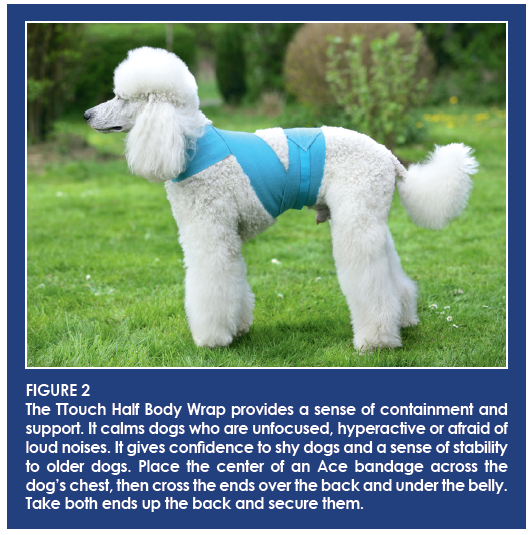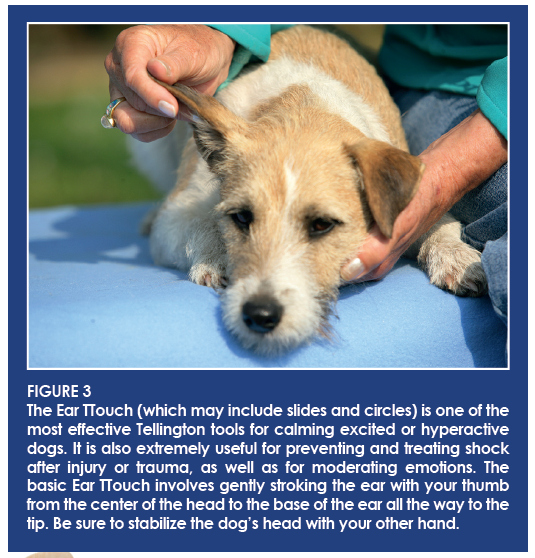How Tellington TTouch resolves canine behavior problems

The Tellington TTouch® Method offers a novel way of shifting your dog’s behavior, leading to a deeper connection and bond with your canine companion. These three case studies show just how effective this technique is.
Much is written about positive reinforcement and other training techniques. They’re all wonderful, but what happens if you are caught in the moment with a misbehaving or difficult dog, and must react on the spot? So many dogs have “issues”, from leash-pulling and inappropriate jumping to aggression and prey behavior. It’s no wonder so many end up in shelters. If your own dog has stubborn or serious behavior problems, Tellington TTouch® may be the answer. Over the last 20 years, the Tellington TTouch Method has helped thousands of dogs and their guardians shift their behavior in just a few sessions, or in the course of six-day training. In this article, we’ll look at three case studies of such breakthroughs, all involving dogs who previously displayed extreme behavioral challenges.
 1. Alexa
1. Alexa
Alexa, a 30-pound mixed breed rescued from Bhutan in south Asia, was hyperactive. She had an uncontrollable habit of chewing on furniture and jumping up to greet people with her mouth. With Tellington TTouch, our goal is to show the dog what we want — in this case, to keep all four paws on the ground with a quiet mouth. I began by hooking a thumb in Alexa’s collar, positioning her sideways, and doing light one-and-a-quarter Basic Circle TTouches (see Figure 1) on her shoulders. In this way, we teach the dog to sit, wait and greet us in a polite way.
Alexa initially panicked when I attempted to hook my thumb in her collar. I sensed her hyperactivity could be due to discomfort and stress caused by dental issues. I began by “containing” rather than “restraining” her, while doing light one-and-a-quarter circles on her shoulders. After a few five-minute sessions, with breaks between, Alexa allowed me to do light TTouches over every inch of her mouth, gums, forehead and cheeks, and along her whole body, without her trying to grab my hand.
By the fourth session, Alexa could greet me without mouthing or jumping up. I am certain that many dogs can change their behavior once we recognize that discomfort may be an underlying factor.
2. Bristol
Bristol (formerly named Pistol) was a shepherd mix brought to my six-day companion animal training session in Austin, Texas. He was overly exuberant, unfocused and pulled on the leash with the full weight of his 70 pounds. He displayed extreme prey drive and was not safe around the family’s beloved cat.
 The five-hour drive to the training session was a challenge for his guardian, Vanessa, with the dog bounding around her Suburban and barking wildly at passing trucks. (Editor’s note: dogs should always be safely restrained while in a moving vehicle, either with a doggy seatbelt or in a secured crate.) He was difficult to control during our introductory session. When I heard his name was Pistol, I suggested that Vanessa change it to something that sounded close but had a different image. The name Bristol was chosen.
The five-hour drive to the training session was a challenge for his guardian, Vanessa, with the dog bounding around her Suburban and barking wildly at passing trucks. (Editor’s note: dogs should always be safely restrained while in a moving vehicle, either with a doggy seatbelt or in a secured crate.) He was difficult to control during our introductory session. When I heard his name was Pistol, I suggested that Vanessa change it to something that sounded close but had a different image. The name Bristol was chosen.
I began by putting a harness on Bristol with two points of contact for the leash, which brings a dog into better balance. Then I placed a Half Body Wrap on him (see Figure 2) to give him a sense of his boundaries and improve his mental and emotional balance.
With the calming effect of the harness and Body Wrap, I was able to make connected Basic Circle TTouches (see Figure 2) in long lines from the shoulders to the hindquarters. Giving dogs a sense of their bodies in this way helps them become grounded and focused.
To deal with Bristol’s prey drive, I suggested Vanessa talk to him as though he could understand, while visualizing clear pictures of what she expected of him regarding her cat. To change a dog’s behavior, you must first change your mind and hold an image of what you want, rather than focusing on the undesired behavior. This core principle is articulated by Gregg Braden in his book, The Spontaneous Healing of Belief — every word, thought, feeling and emotion creates energy.
With the use of TTouch, mindful management and clear intention, Bristol’s behavior shifted. By the end of the first day, he was calmly stretched out in the classroom. In three days, he was a very different dog. On the drive home, he was quiet; when Vanessa stopped for fuel, she was able to walk him without having him pull. Just a few weeks later, he was sleeping near the family cat.
3. Abby
Abby, an 18-year-old Jack Russell terrier, was pacing constantly in the kitchen, pooping and peeing at will. Although she appeared to be deaf and blind, she ate well and could go up and down stairs easily, according to her guardian, Julie. When I arrived at the home, I was warned that she could not be picked up or restrained, and that she would snap to the left if anyone tried to hand-feed her. It can be quite a challenge when a dog cannot be contained enough to go to the vet — and Abby needed to go, since a foul odor emanated from her mouth.
To begin, I sat on the floor in the middle of Abby’s path back and forth across the kitchen. At first, she walked past me with no interest. Around the third time she went by me, I offered her a tasty treat and she snapped to the left, unable to clearly see the treat.
 Each time Abby paced past me, I ran my fingers in light, fast movements from her shoulders to her tail, much as in the children’s game of “Itsy Bitsy Spider” (for more about this unusual TTouch, see “Tarantulas Pulling the Plow” in my book, Getting in TTouch With Your Dog). Abby didn’t speed up, so each time she came past, I made flicking motions with my three middle fingers from her head to her tail. Within ten minutes, she slowed down and allowed a few small, light Basic Circle TTouches (see Figure 3) along her back.
Each time Abby paced past me, I ran my fingers in light, fast movements from her shoulders to her tail, much as in the children’s game of “Itsy Bitsy Spider” (for more about this unusual TTouch, see “Tarantulas Pulling the Plow” in my book, Getting in TTouch With Your Dog). Abby didn’t speed up, so each time she came past, I made flicking motions with my three middle fingers from her head to her tail. Within ten minutes, she slowed down and allowed a few small, light Basic Circle TTouches (see Figure 3) along her back.
After a few more passes, I lightly contained her shoulders and did three quick Basic Circle TTouches directly behind her right ear. Surprisingly, Abby stopped in her tracks and pushed her head sideways against my fingers, clearly appreciating the contact. Then she followed me into an adjoining room and gave my hand one quick lick before turning and walking out.
After that, to Julie’s surprise, Abby accepted connected Basic Circle TTouches along both sides of the spine and more behind her right ear, leaning hard into my fingers. After two more brief sessions, she also allowed me to do Ear TTouches (see Figure 3).
Now that Abby could be picked up, Julie took her to the vet, and eight rotten teeth were extracted. In the ensuing months, Abby now comes to Julie seeking contact and TTouch –something she had never done before.
As these case studies demonstrate, Tellington TTouch is a powerful way to transform canine behavior, even in dogs with extreme or difficult issues.
To learn more about Tellington TTouch
- Getting in TTouch with Your Dog, by Linda Tellington-Jones, PhD, available at ttouch.com or horseandriderbooks.com/product/GEDONE.html.
- All Wrapped Up: Improving Function, Performance and Behavior with Body Wraps, by Robyn Hood with Mandy Pretty, available at ttouch.com
- Facebook, Tellington TTouch World, facebook.com/TellingtonTTouchWorld/




